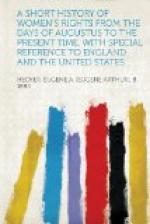We are ready now to observe the status of women in marriage. The question of their legal rights in this relation offers the most illuminating insight into their conditions in the various epochs of history. Matrimony is a state over which the Church has always asserted special jurisdiction. By the middle of the twelfth century it was law in England that to it belonged this prerogative. The ecclesiastical court, for example, pronounced in a given case whether there had been a valid marriage or not; the temporal court took this decision as one of the bases for determining a matter of inheritance, whether a woman was entitled to dower, and the like. The general precepts laid down by canon law in the case of a wife have already been noted. These rules need now to be supplemented by an account of the position of women in marriage under the common law.
Under the older common law the husband was very much lord of all he surveyed and even more. An old enactment thus describes a husband’s duty[395]: “He shall treat and govern the aforesaid A well and decently, and shall not inflict nor cause to be inflicted any injury upon the aforesaid A except in so far as he may lawfully and reasonably do so in accordance with the right of a husband to correct and chastise his wife.” Blackstone, who wrote in 1763, has this to say on the husband’s power to chastise his wife: “The husband also, by the old law, might give his wife moderate correction. For, as he is to answer for her misbehaviour, the law thought it reasonable to intrust him with this power of restraining her, by domestic chastisement, in the same moderation that a man is allowed to correct his apprentices or children, for whom the master or parent is also liable in some cases to answer. But this power of correction was confined within reasonable bounds, and the husband was prohibited from using any violence to his wife aliter quam ad, virum, ex causa regiminis et castigationis uxoris suae, licite et rationabiliter pertinet.[396] The civil law gave the husband the same, or a larger, authority over his wife; allowing him for some misdemeanours flagellis et fustibus acriter verberare uxorem [to give his wife a severe beating with whips and clubs]; for others, only modicam castigationem adhibere [to apply moderate correction]. But with us in the politer reign of Charles the Second, this power of correction began to be doubted; and a wife may now have security of the peace against her husband, or, in return, a husband against his wife. Yet the lower rank of people, who were always fond of the old common law, still claim and exert their ancient privilege; and the courts of law will still permit a husband to restrain a wife of her liberty, in case of any gross misbehaviour.” Doubtless what Mr. Weller, Sr., describes as the “amiable weakness” of wife-beating was not necessarily confined to the “lower rank.” For instance, some of the courtly gentlemen of the reign




